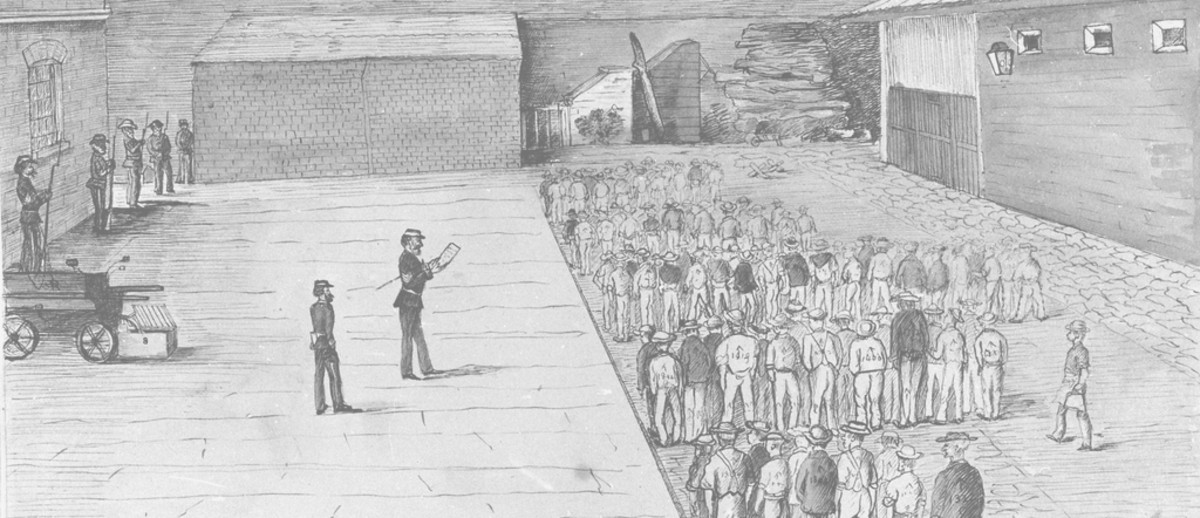Subject
ContributeAlthough South Australia was proclaimed a free settlement, colonial officials soon found they needed a gaol to house lawbreakers. As no provision had been made for one, until June 1837 the governor’s ship, the Buffalo, became the colony’s first prison. While locals blamed crime on felons arriving from the eastern colonies, the reality was that harsh conditions and scarcity of necessities resulted in a rise in excessive drinking and its associated problems.
Adelaide Gaol
A small temporary wooden gaol capable of accommodating about eight prisoners soon became overcrowded. A grand jury recommended a more permanent structure, and Adelaide Gaol, designed by George Strickland Kingston, was opened in 1841 on the banks of the River Torrens in the west parklands. This imposing structure with two towers accommodated debtors and felons both male and female. Its costly construction of Adelaide limestone quarried from the parklands and bricks made on site contributed to the bankruptcy of the colony and recall of the second governor, George Gawler.
Until major additions in 1850, when a section was set aside for women, prisoners were confined between the inner and outer walls and locked up at night in a communal ward. As Adelaide Gaol was merely a place of retention not of correction, prisoners whose sentences were longer than seven years were transported to other colonies.
Yatala Gaol
After the Imperial government abolished such transportation in 1852, Yatala Gaol was established at the site of a large commercial quarry; hard labor and severe discipline were its main features. Unlike the communal ward system at Adelaide Gaol, the ‘separate system’ of single cells for prisoners was introduced.
Regional Prisons
With the spread of population, smaller gaols were built at Robe and Mount Gambier in the South East, Gladstone (1881–1975) and Burra in the Mid North, Port Lincoln on Eyre Peninsula and Wallaroo on Yorke Peninsula. The Police Prisons Act (1905) allowed for sentences of no more than one month to be served at the rural police stations of Fowlers Bay, Kingscote, Renmark, Streaky Bay and Tarcoola.
The conservative prison administration of South Australia lagged behind the other colonies. Although minimum security farm prisons were investigated at the end of the nineteenth century, Kyeema Prison Camp, in the Bangham Forest in the South East between Mount Gambier and Wolseley, was not established until 1923. It was replaced by the open Cadell prison on the River Murray near Morgan in May 1960. Women were accommodated at the Adelaide Gaol and in gaols around the state until a women’s prison was opened at Northfield on 14 December 1969.
Current Prisons
The prisons operating in 2001 were Yatala, Mobilong and Port Augusta, the prison farm at Port Lincoln, the Cadell Training Centre, and Adelaide’s Women’s Prison at suburban Northfield. The newest, Mount Gambier Prison, is the first to be privately managed. Adelaide Gaol, the second oldest public building in the state, closed in February 1988 and is now a tourist attraction, as are other closed country gaols.
Currently, slightly less than 5000 people annually pass through the prison system while a further 20,000 are supervised by 16 community corrections centres.
Media
Add mediaImages

Image courtesy of the State Library of South Australia, SLSA: B 46172, Public Domain

http://commons.wikimedia.org/wiki/File:Adelaide_gaol_tower.jpg, Public Domain.

Image courtesy of the State Library of South Australia, SLSA: B 2434/37, Public Domain.

Image courtesy of the State Library of South Australia, SLSA: B 21925, Public Domain

Image courtesy of the State Library of South Australia, SLSA: B 9288, Public Domain

Image courtesy of the State Library of South Australia, SLSA: B 21925/5, Public Domain

Image courtesy of the State Library of South Australia, SLSA: B 4749, Public Domain



CommentAdd new comment
Quickly, it's still quiet here; be the first to have your say!